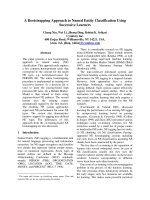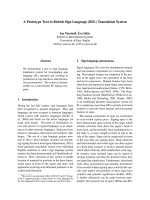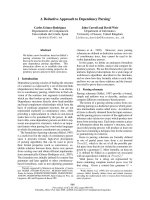Báo cáo khoa hoc:" A useful reparameterisation to obtain samples from conditional inverse" pot
Bạn đang xem bản rút gọn của tài liệu. Xem và tải ngay bản đầy đủ của tài liệu tại đây (230.72 KB, 5 trang )
Note
A
useful
reparameterisation
to
obtain
samples
from
conditional
inverse
Wishart
distributions
Inge
Riis
Korsgaard
Anders
Holst
Andersen
Daniel
Sorensen
a
Department
of
Animal
Breeding
and
Genetics,
Research
Centre
Foulum,
PO
Box
50,
DK-8830
Tjele,
Denmark
i’
Department
of
Theoretical
Statistics,
University
of
Aarhus,
DK-8000
Aarhus
C,
Denmark
(Received
12
December
1997;
accepted
6
January
1999)
Abstract -
A
Bayesian
joint
analysis
of
normally
distributed
traits
and
binary
traits,
using
the
Gibbs
sampler,
requires
the
drawing
of
samples
from
a
conditional
inverse
Wishart
distribution.
This
is
the
fully
conditional
posterior
distribution
of
the
residual
covariance
matrix
of
the
normally
distributed
traits
and
liabilities
of
the
binary
traits.
Obtaining
samples
from
the
conditional
inverse
Wishart
distribution
is
not
straightforward.
However,
combining
well-known
matrix
results
and
properties
of
the
Wishart
distribution,
it
is
shown
that
this
can
be
easily
carried
out
by
successively
drawing
from
Wishart
and
normally
distributed
random
variables.
©
Inra/Elsevier,
Paris
conditional
inverse
Wishart
distribution
/
Gibbs
sampling
/
binary
traits
/
residual
covariance
matrix
Résumé -
Reparamétrisation
permettant
d’obtenir
des
échantillons
tirés
d’une
loi
de
Wishart
inverse
conditionnée.
Une
analyse
bayésienne
utilisant
l’échantillon-
nage
de
Gibbs,
de
caractères
distribués
normalement
conjointement
avec
des
carac-
tères
binaires,
requiert
le
tirage
d’échantillons
dans
une
loi
de
Wishart
inverse
conditionnée.
Il
s’agit
de
la
distribution
a
posteriori
de
la
matrice
de
covariance
résiduelle
des
caractères
distribués
normalement
et
des
variables
latentes
corres-
pondant
aux
variables
binaires.
L’obtention
d’échantillons
correspondants
n’est
pas
évidente.
Cependant
l’utilisation
de
résultats
bien
connus
sur
les
matrices
et
des
propriétés
de
la
distribution
de
Wishart
permet
d’aboutir
à
une
solution
en
tirant
*
Correspondence
and
reprints
E-mail:
or
successivement
dans
une
loi
de
Wishart
et
dans
des
lois
gaussiennes.
©
Inra/Elsevier,
Paris
distribution
de
Wishart
inverse
conditionnée
/
échantillonnage
de
Gibbs
/
caractères
binaires
/
matrice
de
covariance
résiduelle
1.
INTRODUCTION
Markov
chain
Monte
Carlo
makes
possible
the
exploration
of
posterior
distributions
with
relative
ease,
using
models
which
are
computationally
too
complex
to
be
implemented
with
other
approaches.
A
case
in
point
is
the
models
for
a
joint
analysis
of
a
normally
distributed
trait
(such
as
weight
gain
or
yield
of
milk)
and
a
binary
trait
(resistant
or
not
resistant
to
disease,
twin
or
single
birth
in
cattle)
where
the
binary
trait
is
modelled
via
the
threshold
model
!9!,
which
invokes
the
existence
of
an
unknown
continuously
distributed
underlying
variable,
the
liability.
A
Bayesian
analysis
of
such
traits,
using
the
Gibbs
sampler,
requires
the
drawing
of
samples
from
a
conditional
inverse
Wishart
distribution
(e.g.
!3, 5, 8!).
This
is
the
fully
conditional
posterior
distribution
of
the
residual
covariance
matrix
of
the
normally
distributed
traits
and
liabilities
of
the
binary
traits.
Obtaining
samples
from
the
conditional
inverse
Wishart
distribution
is
not
straightforward.
The
purpose
of
this
note
is
to
present
an
easy
method
to
obtain
samples
from
the
conditional
inverse
Wishart
distribution,
where
the
conditioning
is
on
a
block
diagonal
submatrix,
R
22
,
equal
to
the
identity
matrix
of
the
inverse
Wishart
distributed
matrix,
R
=
Ri
l
R1
2
This
is
carried
out
Bit
21
21
R
22
/
by
combining
well-known
relationships
between
a
partitioned
matrix
and
its
inverse
and
properties
of
Wishart
distributions.
The
proposed
method
can
alternatively
be
arrived
at
by
using
both
another
reparameterisation
and
the
properties
of
the
inverse
Wishart
distribution.
This
was
carried
out
in
Dr6ze
and
Richard
[2]
and
is
well-known
in
the
econometric
literature.
The
need
for
sampling
from
a
conditional
inverse
Wishart
distribution
is
motivated
by
a
Bayesian
multivariate
analysis
of
pi
normally
distributed
traits
and
p2
binary
traits,
pl
, p
2
>
1,
using
the
Gibbs
sampler
and
data
augmentation.
2.
THE
MODEL
Assume
that
PI
normally
distributed
traits
and
p2
traits
with
binary
response
are
observed
for
each
animal.
Data
on
animal
i
are
yi
=
(Y;1’Y;2)&dquo;
where
y21!
is
the
observed
value
of
the
jth
normally
distributed
trait, j
=
1, , pl,
and
!2zk
is
the
observed
value
of
the
kth
binary
trait,
=
l, , !2. It
is
assumed
that
the
outcome
of
Y
zk
is
determined
by
an
underlying
continuous
random
variable,
the
liability,
U
ik
,
where
Y;2k
=
1
if
U
ik
>
T
and
Y;2k
=
0
if
U
Zk
<
T,
where
T
is
a
fixed
threshold,
often
assumed
to
be
equal
to
zero.
Let
Wi
=
(Y;
l’
Ui)’
and
define
W as
the
np-dimensional
column
vector,
containing
the
Wi
s,
W’ =
(W!, ,
W!
y ),
p
=
PI
+
pz.
It
is
assumed
that
where
X
and
Z
are
design
matrices
associating
W
with
’fixed’
effects,
b,
and
additive
genetic
values,
a,
respectively.
The
usual
condition,
(R2z)!!
=
1
(e.g.
[1]),
has
been
imposed
in
the
conditional
probit
model
for
Y
i2k
given
a,
k
=
1, ,
p2.
Furthermore
it
is
assumed
that
liabilities
of
the
binary
traits
are
conditionally
independent,
given
b and
a.
The
following
prior
distributions
are
assumed:
b
is
uniform,
and
that
RIR
22
=
Ip
2
follows
a
conditional
inverse
Wishart
distribution
with
density
up
to
proportionality
given
by:
Augmenting
with
the
vector
U
=
(U
1
, , U
n
)’
of
liabilities,
and
also
as-
suming
that
a
priori
b,
(a,
G)
and
R
are
mutually
independent,
it
follows
(e.g.
[5]),
that
the
fully
conditional
posterior
distributions
required
to
im-
plement
the
Gibbs
sampler
are
easy
to
sample
from
with
the
exception
of
the
fully
conditional
posterior
distribution
of
RIR
22
=
Ip
2.
The
fully
condi-
tional
posterior
distribution of
RIR
22
=
Ip
2
is
conditional
inverse
Wishart
distributed
with
density
proportional
to
equation
(2)
with
ER
replaced
by
/
7t
B
-1
freedom
fR
replaced
by
fR,
+
n.
In
the
method
to
be
proposed
for
sampling
from
equation
(2)
in
a
computationally
simple
manner,
the
properties
sum-
marised
below
are
essential.
Assume
that
R-7!(E,/)
and
let
V = R-
1,
then
V - W, (E, f ).
Further-
more,
define
T
=
(T
1
, T
z
, T
3)
by
Tl
=
V
ll
,
T2
=
V
11
1V1
z,
and
T3
=
V
22
.1
= !22 -V2iVii!Vi2;
where
V
= (
V
21
Vlz
J
is
a
partitioning
of V;
V
ll
is
V21
21
V22
pi
x
pi
and
V
22
is
P2
x
pz.
Then
the
following
results
hold:
Result
1:
there
is
a
one
to
one
relationship
between
T
and
R
given
by
Result
5:
(T
l
, T
2)
is
independent
of
T3,
which
implies
that
the
conditional
distribution
of
(T
1
, T
Z)
given
T3
=
t3
is
equal
to
the
marginal
distribution
of
(T
I
, T
2)
Result
1
is
immediate.
Results
2,
4
and
5
all
can
be
found
in
Mardia
et
al.
,
[7]
and
result
3
in
Lauritzen
!6!.
Result
6
follows
from
result
1.
3.
AN
ALTERNATIVE
PARAMETERISATION
Let
R -
IW
P
(E, f
R
+
n)
be
reparameterised
in
terms
of
(T
1,
T2,
T3)
given
by
result
1:
with
the
distribution
of
(T
i,
T2,
T3)
as
specified
in
results
2,
3,
4
and
5.
The
distribution of
R! (R22
=
Ip
J
is
that
of
R! (T3
=
Ip
2)’
This
follows
because
T3
=
R22
is
a
one
to
one
transformation
of R
z2
(property
(10.4.3)
from
calculus
of
conditional
distributions
in
Hoffmann-Jorgensen
(4!)
and
because
of
result
6.
Next
inserting
T3
=
I
P2
in
R
(property
(10.4.4)
in
Hoffmann-Jorgensen
!4!)
it
follows
from
result
5
that
the
distribution
of
R!(T3
=
Ip
2)
is
that
of
From
above
it
follows
that
if
t1
is
sampled
from
Ti -
W
Pl
(1:
11
, f
R
+ n),
next
t2
from
T
21
Tl
=
t1 !
NP
l
XP
2 (1:
1
/1:1
2
, t1
l
1 !
£
22
. i ) ,
then
is
a
realised
matrix
from
the
conditional
inverse
Wishart
distribution
of
R
given
R
22
=
Ip
2’
4.
CONCLUSION
We
have
presented
a
simple
method
to
draw
samples
from
conditional
inverse
Wishart
distributions.
The
conditioning
is
on
R
22
equal
to
the
identity
matrix,
where
R
=
R2
1
R.12
)
is
a partitioning
of
an
inverse
Wishart
R21
R22
distributed
matrix.
The
method
is
relevant
in
a
Bayesian
joint
analysis
of
normally
distributed
and
binary
traits
(the
latter
with
associated
liabilities),
using
the
Gibbs
sampler.
The
methodology
was
illustrated
based
on
models
with
additive
genetic
effects
only.
The
generalisation
to
several
random
effects
is
immediate.
ACKNOWLEDGEMENT
The
authors
would
like
to
thank
a
referee
for
useful
comments
and
suggestions.
REFERENCES
[1]
Cox
D.R.,
Snell
E.J.,
Analysis
of
Binary
Data,
Chapman
and
Hall,
London,
1989.
[2]
Drèze
J.H.,
Richard
J F., Bayesian
analysis
of
simultaneous
equation
systems,
in:
Griliches
Z.,
Intriligator
M.D.
(Eds.),
Handbook
of
Econometrics,
North-Holland
Publishing
Company,
vol.
1,
1983,
pp.
587-588.
[3]
Jensen
J.,
Bayesian
analysis
of bivariate
mixed
models
with
one
continuous
and
one
binary
trait
using
the
Gibbs
sampler,
Proceedings
of
the
5th
World
Congress
on
Genetics
Applied
to
Livestock
Production
18
(1994)
333-336.
[4]
Hoffmann-Jorgensen
J.,
Probability
with
a
View
toward
Statistics,
Chapman
and
Hall,
New
York,
1994.
[5]
Korsgaard
LR.,
Genetic
analysis
of
survival
data,
Ph.D.
thesis,
University
of
Aarhus,
Denmark,
1997.
[6]
Lauritzen
S.L.,
Graphical Models,
Oxford
University
Press,
New
York,
1996.
[7]
Mardia
K.V.,
Kent
J.T.,
Bibby
J.M.,
Multivariate
Analysis,
Academic
Press,
Great
Britain,
1979.
[8]
Sorensen
D.,
Gibbs
sampling
in
quantitative
genetics,
Internal
report
no.
82
from
the
Danish
Institute
of
Animal
Science,
1996.
[9]
Wright
S.,
An
analysis
of
variability
in
number
of
digits
in
an
inbred
strain
of
guinea
pigs,
Genetics
19
(1934)
506-536.









